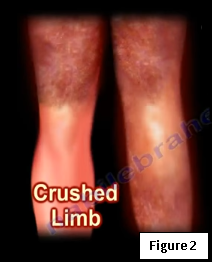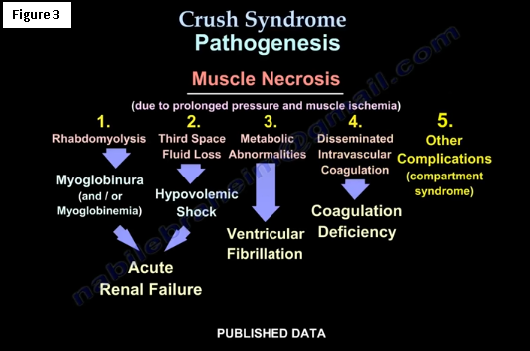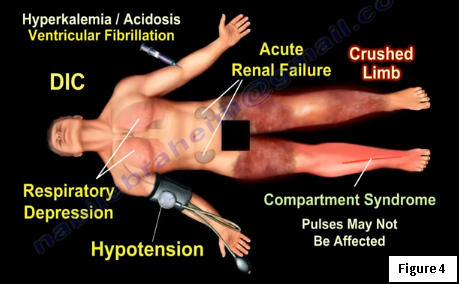
Crush syndrome occurs due to crushing accidents such as those seen in war zones, industrial accidents, and natural disasters— most commonly with earthquakes, or it can occur due to drug overdoses or the positioning during a long surgery (Figure 1). When the muscle is crushed, this results in muscle necrosis (Rhabdomylolysis and Myoglobinuria). The crush injury causes muscle breakdown resulting in the release of toxic muscle cell components and electrolytes into the blood stream causing third space fluid loss and acute renal failure. Crushing of the limbs or the trunk can create a very harmful systemic affect.

Crush injuries occur more in the lower extremities than in the upper extremities and the trunk (Figure 2). Some patients with crush injuries will have acute renal failure, require dialysis, and/or fasciotomies.
The three main conditions associated with crush syndrome are local muscle damage, organ dysfunction, and metabolic abnormalities. If the patient is not treated properly, they could die within days.

The crushing injury and limb compression will lead to a soft tissue injury. This injury causes ischemia which can result in compartment syndrome or muscle necrosis. During muscle necrosis, microcirculation is affected, provoking the muscles to swell and causing irreversible damage to the muscles and nerves. Muscle necrosis occurs due to prolonged pressure and muscle ischemia. Muscle ischemia can lead to Rhabdomylosis which can cause Myoglobinura (and/or myoglobinemia). It can also cause Third Space Fluid Loss which can produce hypovolemic shock. Both Myoglobinura and hypovolemic shock can lead to acute renal failure. Muscle necrosis can cause metabolic abnormalities which can result in ventricular fibrillation. Metabolic acidosis and hyperkalemia will lead to cardiac arrhythmia. Disseminated intravascular coagulation can occur from muscle necrosis, creating a coagulation deficiency. Other complications, such as compartment syndrome, can occur as well. (Figure 3)
The clinical picture is presented here in the diagram below (Figure 4). You can see the hypotension, crushed limbs, acute renal failure, DIC, and compartment syndrome—the pulses may not be affected. In the image, you can see the respiratory depression as well as the ventricular fibrillation that may happen, hyperkalemia, and metabolic acidosis.

A multidisciplinary approach involving the medical and surgical team is necessary in treating crush syndrome. Non-surgical treatments will include fluid replacement—ideal fluid is normal saline, ventilatory support, the correction of metabolic acidosis, and dialysis may need to be considered. A surgical team may be required to perform an emergency fasciotomy because compartment syndrome can occur even when a patient is trapped less than an hour. Compartment syndrome can happen without a fracture and even when good pulses are felt. An early fasciotomy must be done. Surgery may also be necessary to debride necrotic muscle and to apply a VAC for wound coverage. A skin graft may be needed to in these situations.
Mortality can occur early from hypovolemia and hyperkalemia or, it can occur late from multiple organ failure and sepsis.
For more information on traumatic conditions, follow the links below:
For more information on Orthopaedic conditions, check out my YouTube page at:
